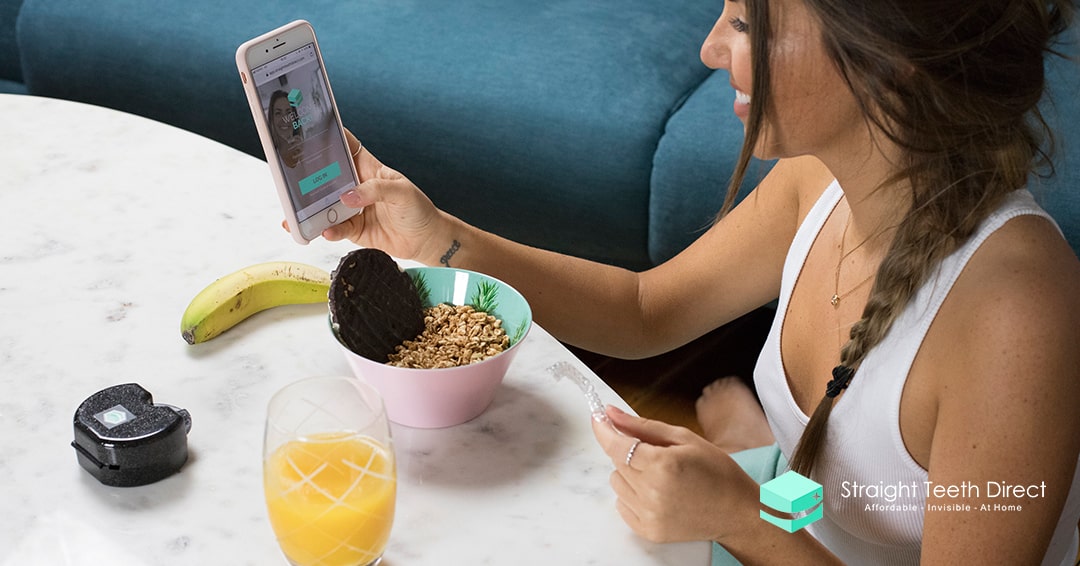
Aligner monitoring: at home vs. in clinic

With in clinic fixed braces – the results depend on the dentist and how they fitted the brackets and wires. With aligners – the results depend on the design of the technician, and how much the patients commit to wear the aligners. Once the aligners have been made then the dentist needs to track how the teeth are moving and if it’s on course. But let’s look at what actually happens with aligner monitoring in clinic vs. at home.
#1 Aligner monitoring history: from subjective to predictable
They developed from Harold Kesling’s work on a type of orthodontic positioner which he then suggested an orthodontic setup, where the teeth would be delicately sawed and separated on a stone model, then reset in wax then moved into the new position. This enabled physical models to be created with the intermediate stages of tooth movement. These models were then used to create clear aligners by pressure forming plastic over the models. This process required the physical production of many intermediate models, and then the manufacture of the aligners for each model.
As you can begin to understand, the aligners depended entirely on how the technician set each model, how much movement they made per model. They would then deliver the appliances to the dentist who would then give them to the patient. The dentist was not able to change or influence the aligners apart from doing small modifications with pressure pliers to enable small dimples on the aligner to increase pressure in some places, but they could not change the amount of movement, directions of movement or rate of movement. This was all determined by the orthodontic technician albeit on a prescription from the dentist, but in reality dentists are not able to prescribe movement stages as they don’t know what is possible per clear aligner and how to best organise tooth movement to ensure a good outcome.
Fast forward to modern day. Clear aligners are now made on 3D printed models designed on a computer with special 3D software so no more wax, BUT it is still the technician planning and designing the actual movements at the lab; the dentist may recommend or request certain movements but they do not actually do them.
A dentist may glue brackets and bend wires themselves to make teeth move exactly as they wish, but they do not really control or direct orthodontic movement with aligners, which is why many dentists don’t like aligners (due to a lack of control on how they work), poor experiences from aligners made by inexperienced technicians can destroy confidence in treatment modalities. There is no easy way to look at an aligner and determine if it is programmed correctly or not. This can only be determined through proper design protocols then detailed tracking and aligner monitoring. Which brings us to aligners in everyday use.
Before if you wanted aligners you had to buy them directly in a dental practice. Nowadays thanks to teledentistry platforms like Straight Teeth Direct™ you are able to buy them from the comfort of your own home. Let’s look at the difference between in-clinic aligner monitoring and remote aligner monitoring via a multichannel platform like Straight Teeth Direct™ (be aware this unique protocol and advanced aligner monitoring is specific to Straight Teeth Direct™ and other at home aligner brands don’t actually monitor progress this way, if at all).
#2 Aligner monitoring in clinic
In this model you can see the dentist really just delivers the aligners and takes impressions. They can’t really change anything or track. Plus in between appointments when the patient is at home they aren’t able to track how the patient is getting on, or answer any questions on demand or even see where the teeth should be for this stage of movement.
| Service | Location | Result |
|---|---|---|
| Initial Assessment | In Clinic | Find out if suitable |
| Initial Records & Impressions | In Clinic | Take Impressions |
| Review Simulation | In Clinic | See new smile |
| Order Aligners | In Clinic | Pay for aligners |
| First Aligners | In Clinic | Insert Aligners |
| Redo Impression | In Clinic | If any issue dentist must redo impressions |
| First batch of aligners | At Home | Patient wears the aligners by themselves, there is no checking by the dentist |
| Aligner Review | In Clinic | Dentist asks if aligners fit They aren’t able to compare against predicted result for this month really, as they don’t have that information |
| Aligner Reboot | In Clinic | If aligners not working, dentist takes new impressions and then requests new setup |
| Second batch of aligners | At Home | Patient wears the aligners by themselves, there is no checking by the dentist |
| Aligner Review | In Clinic | Dentist asks if aligners fit They aren’t able to compare against predicted result for this month really, as they don’t have that information |
| Completion & Retainer | In Clinic | Receive Retainers and finish treatment. If you lose your retainers you need new impressions |
| Lost Retainer – Replacement | In Clinic | New impression taken for retainers (unfortunately the teeth are held in the crooked position) if you want them re-straightened you need to pay for aligners again and repeat the process |
#3 Advanced aligner monitoring at home
Here you can see the dentist and lab are able to more closely monitor the patient’s progress: they can see the photos for each stage and compare the tooth position with the 3D predicted model for each stage, and if any changes are needed the lab can alter the aligners as needed immediately before they are produced. This enables almost real time tracking and monitoring without wasted appointments or products, whilst simultaneously increasing the predictability, and tracking of tooth movement as you have exact % progress.
| Service | Location | Result |
|---|---|---|
| Initial Assessment | At Home | Find out if suitable with a dentist-evaluated e-consultation |
| Initial Records & Impressions | At Home | Take dental impressions + Upload Records |
| Review Simulation | At Home | See 3D simulation of new smile + Ask any questions |
| Order Aligners | At Home | Pay a fixed amount for the full treatment (all-inclusive price) |
| First Aligners | At Home | Insert aligners |
| Redo Impression | At Home | In case of any issues, redo impressions at home. |
| First batch of aligners | At Home | Patient wears the aligners by themselves, answers dentist via the app for first review |
| Aligner Review | At Home | Track the fit and comfort of aligners and answer initial questions |
| Monthly Review | At Home | Track the fit, % progress, comfort and answer questions |
| Aligner Reboot | At Home | In case of any issues, redo impressions at home. |
| Second batch of aligners | At Home | Patient wears the aligners by themselves and answers the assigned dentist via the app |
| Aligner Review | At Home | Track the fit, % progress, comfort and answer questions |
| Completion & Retainer | At Home | Receive 1 set of complementary retainers & Sign up for the Maintainer Plan to guarantee peace of mind to never pay for braces again |
| Lost Retainer – Replacement | At Home | Simply order your replacement retainer and it is digitally made and sent to you. If your teeth have moved and you are on the Maintainer Plan you also receive some replacement aligners to re-straighten your teeth |
The percentage progress bar on the app keeps users on track and motivated to keep on wearing the aligners; they can also go back to old monthly review pictures to see how far they’ve come.

Mairead, another user, reported:
“Not only is the process so convenient not having to attend appointments, but it actually feels like having your own personal orthodontist on call.”
As technology evolves more and more it is crucial to capture as much information as possible to enable better results. It’s clear here that aligner monitoring through a teledentistry platform is more predictable, efficient and convenient for both users and dentists and shaping the future of teeth straightening.

Not quite sure yet?
Fill in your email and we'll send you more details!
















